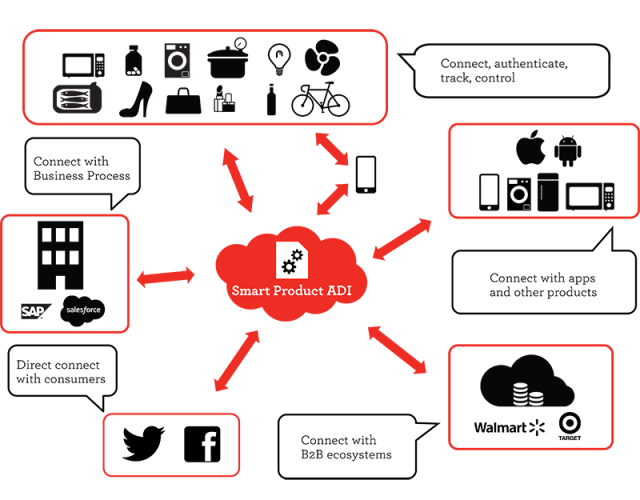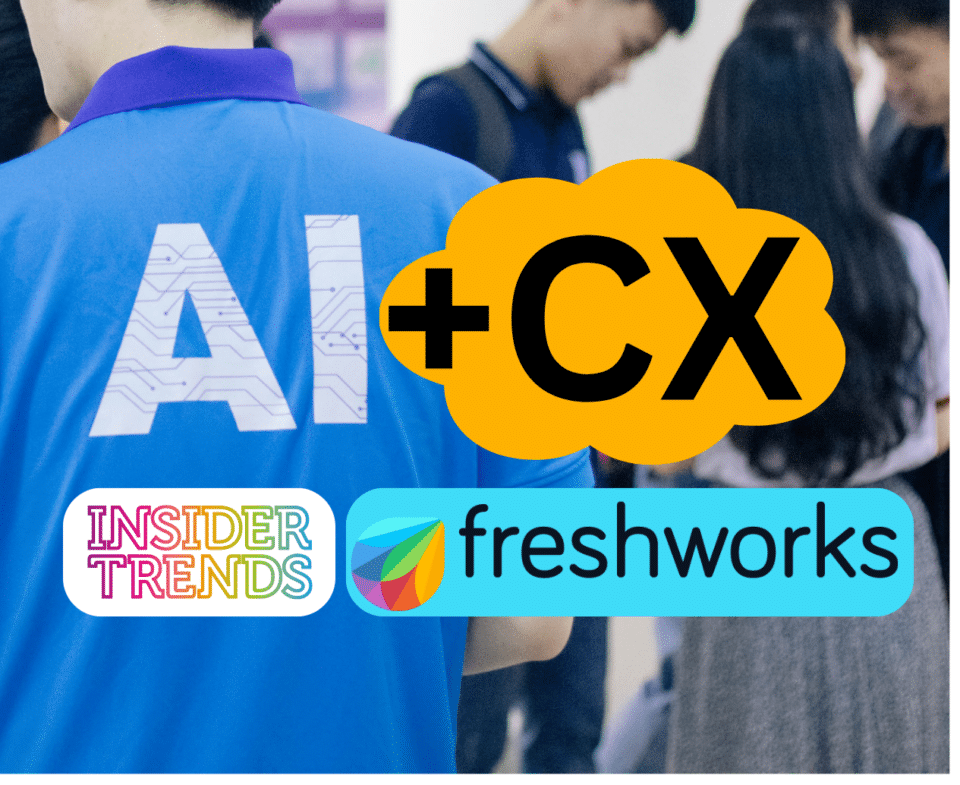Interview with Andy Hobsbawm of EVRYTHNG

EVRYTHNG is an exciting new company which deals with the Web of Things and its applications in a retail and commercial environment. The EVRYTHNG Engine makes it easy to assign a unique digital identity to any physical object, allowing businesses and consumers to engage, communicate and form relationships like never before.
Here at Insider Trends we recently caught up with Andy Hobsbawm, Founder and Chief Marketing Officer at EVRYTHNG, to discuss exactly what they do and how they are innovating the retail industry.

How would you describe what EVRYTHNG does, so that someone like my grandmother would understand?
Imagine if every product had its own digital life. EVRYTHNG’s software helps brands connect their products to the Web. This lets consumers use smartphones to connect with the things they buy and use, unlocking digital content, rewards and experiences and getting more out of their products.
Your grandmother might also like to watch this 77 second animation, which explains the EVRYTHNG proposition:
Could you tell us a little about the Internet of Things and the Web of Things?
The Internet of Things (IoT) is how things communicate with each other – voice, sounds, visually, and so on. In other words,it is the medium of communications. The Web of Things is what things say to each other – their language and the associated semantics.
The internet itself was invented in the 70’s but it didn’t take off before the Web made it useful, friendly and accessible – over 20 years later! Likewise, the IoT was invented in the 1990s, but did not take off until the WoT made it useful, friendly and useful – which is just what we do!
The Web of Things (WoT) is about connecting physical objects to the Web, so that they may provide the kind of real-time, social web experiences we’ve come to expect in our daily lives. Imagine physical products that are as clever as Google, as immediate as Twitter, as informative as Wikipedia, as social as Facebook, as personal as Amazon and as entertaining as YouTube.
In other words, the WoT allows physical objects to communicate in the same language as everything else, in order to participate and integrate seamlessly into those conversations. For example, communicating RSS to your newsfeed client, tweeting to your Twitter friends, scheduling a blog post via WordPress APIs, and so on.
What sort of applications does the Web of Things have in both residential and business environments?
The applications of the WoT really are as limitless as the Web itself. We envision a world where any individual object – from consumers’ personal possessions, to supply chain components, to trains, buildings and paintings – each has its own unique digital identity with an active online presence.
For example, imagine a washing machine informing a consumer of where to find the cheapest replacement parts, or medication keeping track of how many tablet’s you’ve taken and reminding you to take the next one. You could even find a meat product which could vouch for its authenticity and provenance before you buy it, allowing you to track its movements through the supply chain, just like how you’d track a FedEx package on an app today.
From the perspective of the supply chain, you can improve the business behind products by capturing real-time analytical data about where, how and when products are being made, used and sold. EVRYTHNG’s technology provides products with an identity, allowing businesses to determine where and when it has been scanned by an employee or by an end-consumer. Using sensor feeds, they can capture geo-location data, as well as any other information communicated directly from the product itself. All of this information can easily be linked to their MES (Manufacturing Execution System), ERP (Enterprise Resource Planning) or alternative supply chain information system.
We also need to be aware that the long-term economic, social, political and cultural impact of the Internet of Things should not be underestimated. A global network connecting all physical devices, while creating a new interconnected Web of information, people and physical things, is definitely a game-changer. It’s hard to think of a single industry that won’t be affected if the physical objects which it produces, the assets it owns or the machines it utilises can connect and exchange information with each other and with the people who own or operate them.

What will happen to the automobile industry, for example, when cars can talk to roads? What happens to the healthcare industry when patients or doctors can ask their medication or medical equipment for real-time information and feedback? What happens when individuals can customise and communicate with their everyday objects and environments? When they track usage, make and receive recommendations, and re-wire how they work with simple web interfaces – as easily as you can drag and drop videos, URLS and photos into a Tumblr web page today?
Consider the far-reaching impact of a new technology like railways in America. The opportunity to transport goods over thousands of miles transformed the face of modern business. Corporations grew much larger, requiring bigger buildings and new forms of organisation. And so, secretaries and middle management were invented, along with typewriters, skyscrapers and elevators. In other words, the domino effect which the the railroads caused over subsequent decades, along with ‘general purpose technologies’ like electrification, was extraordinary. We expect the impact of the IoT to be equally transformational. 
Aside from the newness of the technology, exactly how is EVRYTHNG future-focused and innovative as a company?
Our mission is to make every physical thing in the world addressable and part of the Web. We do this by giving objects unique Web profiles – what we call an Active Digital Identity™ – and we are unique in doing this. Imagine a ‘Facebook for Things’ where physical objects, just like people on social networks, have a permanent online profile through which they can connect and communicate with users and applications.
Here at EVRYTHNG we believe that identity is the cornerstone of an emerging WoT. Our vision is a world where every object has an Active Digital Identity™ on the Web, and we see a transactional economy with data flowing to, from and between these objects via various channels. The EVRYTHNG Engine technology makes it easy to create these online profiles, turning any physical object into a channel for personalised digital services, one-to-one communications and ongoing relationships. You can read more about our Web Objects here and our Product Relationship Management system here.
We use a combination of these intelligent identities for physical products on the Web, alongside tagging and sensor technology and smart mobile devices, to deliver a portfolio of managed services applications. We focus specifically on product personalisation and loyalty, sales and service, and tracking & analytics apps. We make it easy for companies to deploy innovative experiences and services today, bridging the physical and digital world and using their products to connect them directly to their customers and partners.
Who have you collaborated with or worked alongside? How did you find this process?
Collaboration is an essential part of how we work. We see EVRYTHNG’s software as part of an ecosystem alongside many other technology players and channel partners. Because of this, it’s probably unsurprising that we’re currently collaborating with many companies.
For instance, EVRYTHNG is currently taking part in the three year EU COMPOSE project, working with big names like IBM, the World Wide Web Consortium (through ERCIM), several European universities and the Barcelona Supercomputing Centre. The overall aim is to develop an open technical framework for IoT applications and services to connect with each other, making it fast and easy to bring them to market. We recently led the first public showcase of the beta IoT platform exclusively at the Web of Things Workshop, which is organised annually by EVRYTHNG.
We have also collaborated with global marketing networks like Omnicom Media Group, Draftfcb and M&C Saatchi. We help their clients to improve physical and digital customer engagement, just by making their products smart. Another exciting company we’ve worked with is iZipline, where we focused on the possibility of delivering digital content to consumers through their smartphones – from promotional and instructional videos to redeemable coupons.
What do you expect to come next for EVRYTHNG, and the Web of Things in general?
Mass consumer adoption of WoT technologies this year will most likely come from wearables – which we think will get pretty big this year. You can see this in the increasing number of sports and health instrumentation products, measuring things like glucose, blood, sweat, sleep monitoring, weight, and so on – not to mention the health of our plants and pets. There are a tremendous numbers of similar products hitting the market now, and in addition to being stand alone propositions, we’re beginning to see some wider integration into the health and wellness industry. For example, we’re looking into connecting fitness data with health insurance premiums, gym programs and so on.

As for EVRYTHNG, we’re continuing to work on our technology platform and applications for things like consumer-product loyalty and smart product tracking and analytics. We will also continue to build partnerships with marketing and packaging companies, and other players in the tech ecosystem for connecting people and products. Of course, we’ll also continue to launch new smart product campaigns and applications with our global brand customers. Our aim is to be managing a billion Active Digital Identities™ on our platform within the next few years.
Which three companies, brands or agencies do you consider to be the most innovative in your particular line of work? Does anyone else inspire you?
Here at EVRYTHNG we’re fascinated by the idea of any physical thing having its own digital identity. From a tech perspective, WEIO offers an easily accessible platform for users to connect and control their objects from any device in an easy and intuitive way. The barrier of technical programming is removed, instead encouraging users to focus on design and innovation.
Of all the consumer companies, Nike is probably the most advanced in smart product thinking. The company has revolutionised its relationship with consumers by turning products into ongoing, socially-connected digital services, like Nike+ or Fuelband.



